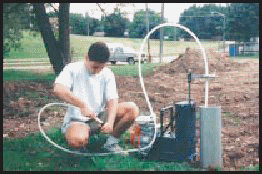|
WATER HARDNESS
CALCULATOR
|
Hard waters
are generally considered to be those waters that require considerable
amounts of soap to produce a foam or a lather, and that also produce
scale in hot-water pipes, heaters, and boilers. Hard waters are as
satisfactory for human consumption as soft waters.
Hardness is
caused by multivalent metallic cations. The principal
hardness-causing cations are the divalent calcium, magnesium,
strontium and manganese ions. The hardness in water is derived mostly
from contact with the soil and rock formations. In general, hard
waters originate in areas where the topsoil is thick and limestone
formations are present.
Hardness is
normally expressed in terms of CaCO3 . One of the most accurate methods
of determining hardness is by calculation based upon the concentration
of divalent ions
found through a complete cation analysis.
The
calculation of the hardness caused by each ion is performed by the
following equation:
Hardness
(in mg/L) as CaCO3 = M2+ (mg/L) x (100 g/mol
CaCO3/ atomic weight of M2+)
The
following calculator determines the hardness of waters based on the
concentrations of the divalent cations Ca, Mg, Mn, Fe and Sr.
|
|
There are many resources
available for more information on water hardness. For this
newsletter the following textbooks were used:
Appelo, C.A.J., and D.
Postma (1996). Geochemistry, Groundwater and Pollution.
Published by A.A. Balkema Publishers, Netherlands.
Drever, J.I. (1988).
The Geochemistry of Natural Waters, Second Edition. Published
by Prentice-Hall Inc., New Jersey, USA.
Sawyer, C.N., P.L. McCarty,
and G.F. Parkin (1994). Chemistry for Environmental Engineering.
Published by McGraw-Hill, Inc., New York, USA
Return to top of
Newsletter
|
|

Click here for the best
price a WaTerra Pump
Back to top of
Newsletter
|
The WaTerra Pump is a simple,
reliable inertial pump which uses an age old, proven technology, in an
elegant manner uniquely adapted to the needs of modern groundwater
monitoring.
|
|
|
How does the WaTerra
pump work?
The pump consists of a riser
tube with a one-way valve at the foot and a surface pumping mechanism.
The valve allows water to enter the tubing as it is pushed downwards
and retains the water when the tube is pulled upwards again. The
inertia of the water itself provides the force to carry it up to the
surface whenever the tube is being pumped up and down. The water
travels in a continuous column, with little disturbance, thus
retaining volatiles. To obtain a sample, the tube and foot valve
are lowered to the desired depth and rapidly pumped up and down,
either manually or mechanically.
Back to WaTerra pump list
|
|
What type of flow rates
can be achieved?
Flow rate is a function of the
momentum generated in the tubing. It varies with tubing length,
submergence depth, depth of the foot valve, flexing of the tube, and
with the pumping rate. Up to 2 gallons/minute are possible with
a hand pump and flexible tubing, and up to 4 gallons/minute with a
control unit and 1" tubing. Higher volumes are obtained with two
or more pumps strapped together for simultaneously pumping.
Back to WaTerra pump list
|
|
Can it be dedicated to
a well?
WaTerra pumps are ideal for
dedication into a well They are low in cost (just a little more
than a bailer), reduce field time, fast and easy operation, avoids
cross-well contamination, avoids costly field blanks, and eliminates
repeated pump decontamination.
Back to WaTerra pump list
|
Where can it be used?
The WaTerra pump is very
versatile. It is excellent for use in silty/sandy environments,
is ideal for well development, operates to over 250 ft (75 meters),
and works for small well diameters (0.5" to 6" ID).
Back to WaTerra pump list
|
|

